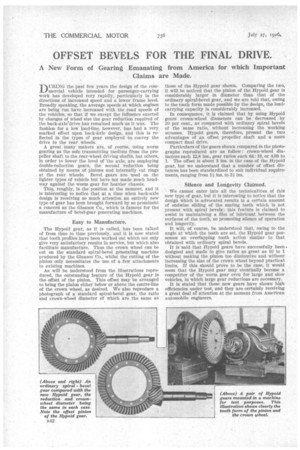OFFSET BEVELS FOR THE FINAL DRIVE.
Page 26

If you've noticed an error in this article please click here to report it so we can fix it.
A New Form of Gearing Emanating from America for which Important Claims are Made.
TAURING the past few years the design of the com mercial vehicle intended for passenger-carrying work has developed very rapidly, particularly in the directions of increased speed and a lower frame level. Broadly speaking, the average speeds at which engines are being run have increased with the road speeds of the vehicles, so that if we except the influence exerted by changes of wheel size the gear reduction required of the back-axle-drive has remained much as it was. The fashion for a low load-line, however, has had a very marked effect upon back-axle design, and this is reflected in the types of gear employed to, convey the drive to the rear wheels.
A great many makers are, of course, using worm gearing as the sole transmitting medium from the propeller shaft to the rear-wheel driving shafts, but others, in order to lower the level of 'the axle, are employing double-reduction gears, the second reduction being obtained by means of pinions and internally cut rings at the rear wheels. Bevel gears are used on the lighter types of vehicle but have not made much headway against the worm gear for heavier chassis.
This, roughly, is the position at the moment, and it is interesting to notice that at a time when back-axle design is receiving so much attention an entirely new type of gear has been brought forward by so prominent a concern as the Gleason Co., which is famous for the manufacture ot bevel-gear generating machines.
Easy to Manufacture.
The Hypoid gear, as it is called, has been talked of from time to time previously, and it is now stated that tooth profiles have been worked out which not only give very satisfactory results in service, but which also facilitate manufacture. Thus the crown wheel can be cut on the standard spiral-bevel generating machine produced by the Gleason Co., whilst the cutting of the pinion only necessitates the use of a few attachments to existing machines.
As will be understood from the illustrations reproduced, the outstanding feature of the Hypoid gear is the offset of the pinion. This offset may be arranged to bring the pinion either below or above the centre-line of the crown wheel, as desired. We also reproduce a photograph of a standard spiral-bevel gear, the ratio and crown-wheel diameter of which are the same as those of the Hypoid gear shown. Comparing the two, it will be noticed that the pinion of the Hypoid gear is considerably larger in diameter than that of the ordinary spiral-bevel gear, and we are told that, owing to the tooth form made possible by the de:..oign, the loadcarrying capacity is considerably increased.
In consequence, it is claimed that by using Hypoid gears crown-wheel diameters can be decreased by 10 per cent., as compared with ordinary spiral bevels of the same ratio, without increasing the working stresses. Hypoid gears, therefore, present the two advantages of an offset propeller shaft and a more compact final drive.
Particulars of the gears shown compared in the photographs reproduced are as follow : crown-wheel diameters each 12.8 ins., gear ratios each 64: 13, or 4.93 to 1. The offset is about 3 ins, in the case of the Hypoid gear, but we understand that a number of offset distances has been standardized to suit individual requirements, ranging from 11 ins. to 31 ins,
Silence and Longevity Claimed.
We cannot enter into all the technicalities of this new type of gear, but it is interesting to notice that the design which is advocated results in a certain amount of endwise sliding of the mating teeth which is not present with spiral bevels; this feature is claimed to assist in maintaining a film of lubricant between the surfaces of the teeth, so promoting silence of operation and longevity.
It will, of course, be understood that, owing to the angle at which the teeth are set, the Hypoid gear possesses an overlapping tooth action similar to that obtained with ordinary spiral bevels.
It is said that Hypoid gears have successfully been. designed and made to give ratios as great as 10 to 1 without making the pinion too diminutive and without increasing the size of the crown wheel beyond practical limits. If this should prove to be the case, it would seem that the Hypoid gear may eventually become a competitor of the worm gear even for large and slow vehicles, in which large gear reductions are necessary.
It is stated that these new gears have shown high efficiencies under test, and they are certainly receiving a great deal o? attention at the moment from American automobile engineers.






























